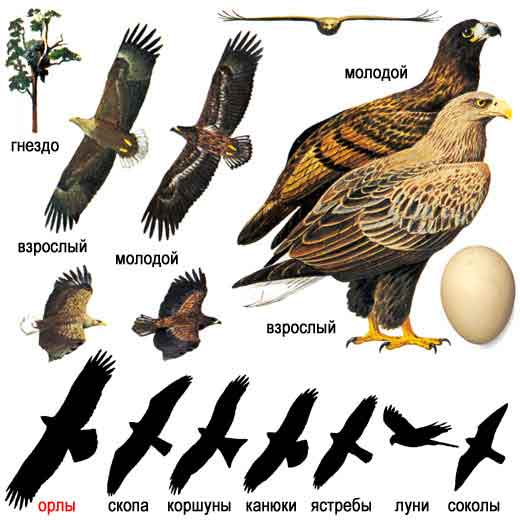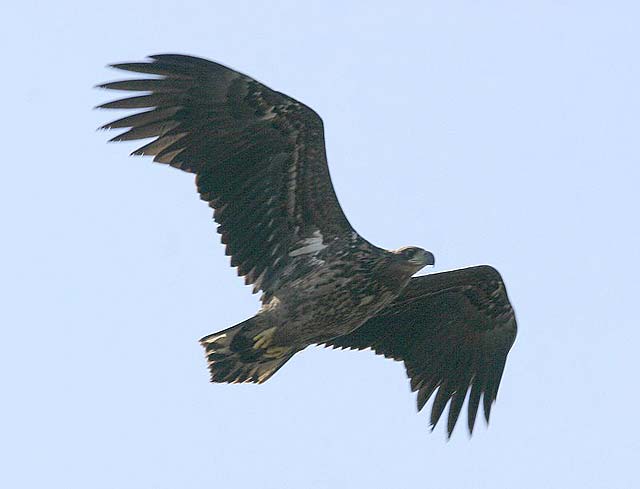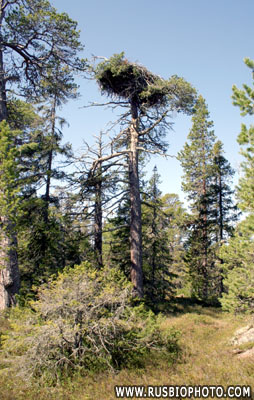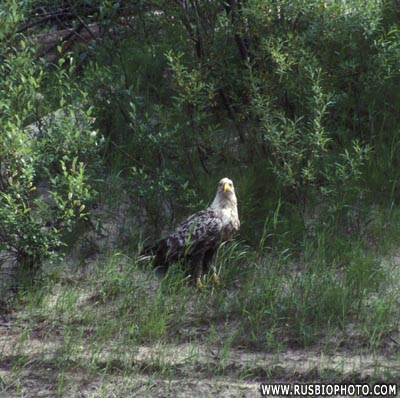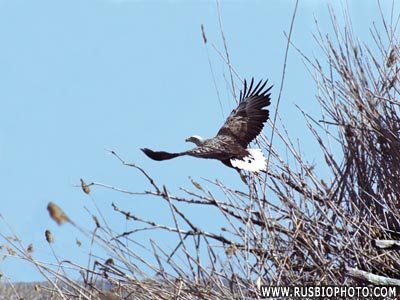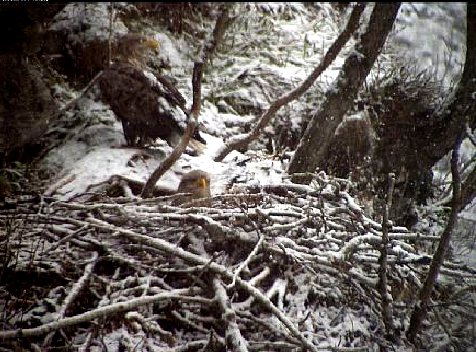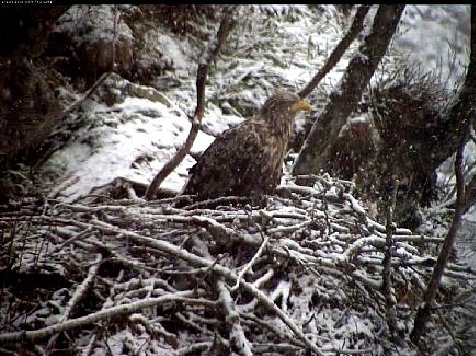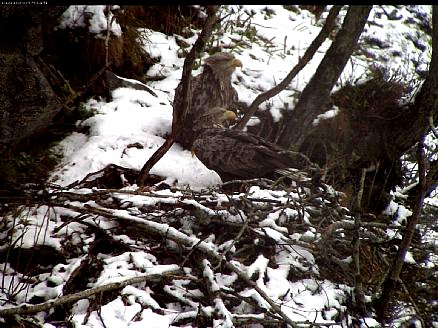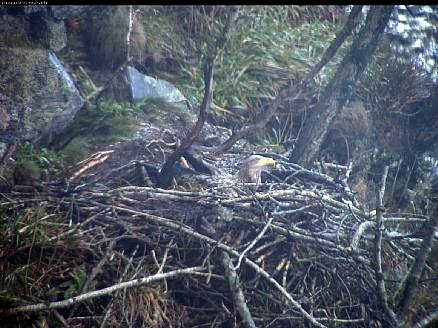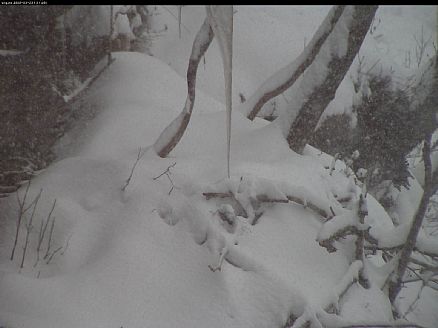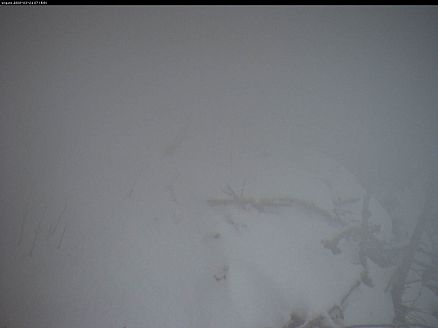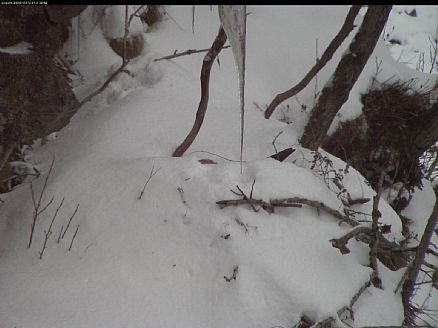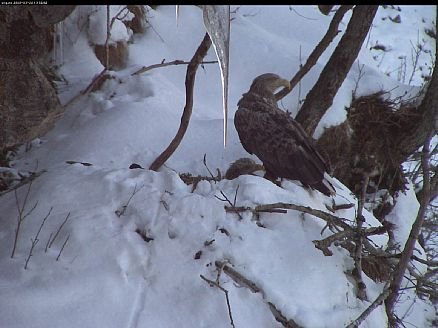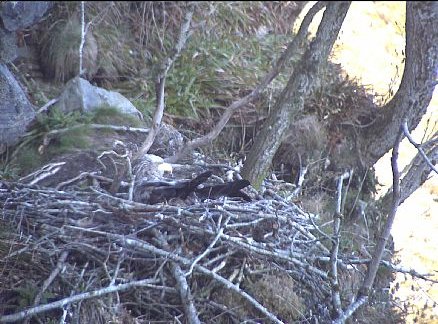|
Wind
farm causes eagle deaths
03-02-2006
Wind
turbines have caused a number of deaths of Europe's largest
eagle species, on isolated islands off the Norwegian coast.
The
discovery of four dead White-tailed Eagles, and the failure
of almost 30 others to return to nesting sites within the
wind farm area, has increased fears that wind farms elsewhere
could take a similar toll on native and migrating
wild birds.
The
White-tailed Eagle Haliaeetus albicilla is found in significant
numbers on Smøla, a set of islands about ten kilometres
off the north-west Norwegian coast. The island is listed by
BirdLife as an Important Bird Area (IBA) because it holds
one of the
highest breeding densities of the species in the world.
The
four dead birds were found between August and December 2005.
Two had been sliced in half, apparently by a turbine blade.
Post mortems blamed multiple trauma for the birds' deaths,
caused by a heavy blow. Much of the wind park is remote and
rarely visited and it is possible that other deaths have gone
undetected.
The
68-turbine Smøla wind farm was built between 2001 and
2005. The Norwegian government ignored advice based on an
environmental assessment, warning against the development
because of the danger it posed to White-tailed Eagles. BirdLife
took the case to the Bern Convention but the decision was
not overturned.
Research
by NOF-BirdLife Norway’s National White-tailed Eagle
project, the Norwegian Institute for Nature Research (NINA)
and the RSPB (BirdLife in the UK), will now be stepped-up
to include regular checks for casualties throughout the wind
park,
and monitoring of this spring's breeding activity.
Conservationists
are yet to draw firm conclusions from their initial monitoring
because breeding numbers of eagles often vary
and in 2004 and 2005, construction activity for the second
part of the wind park was especially intense.
"Breeding
results on Smøla have been strikingly poor compared
with the 30 years before the wind farm was built, both on
the
site itself and the remainder of the island." —Alv
Ottar Folkestad, NOF (BirdLife in Norway)
Alv
Ottar Folkestad, project leader of NOF’s National White
tailed Eagle project for more than 30 years said, "We
are only
half way through the research, yet despite their site-faithfulness,
we are not confident that White-tailed Eagles will adapt to
the turbines and return to the wind park area. As older birds
die, we do not know if new birds will occupy nest sites within
the
wind farm."
BirdLife
supports the generation of wind and other renewable energies
to help tackle climate change but these interim research results
have underlined the dangers of wind parks placed near sites
that birds instinctively seek.
http://www.birdlife.org/

The
dead adult female on this picture was No. 7 killed in the
Smøla wind-farm.
Photo © Espen Lie Dahl
Wind farm 'hits eagle numbers'
Friday, 23 June 2006
The white-tailed eagle is one of Europe's largest birds of
prey
Wind farm turbine blades are killing a key population of Europe's
largest bird of prey, UK wildlife campaigners warn.
The RSPB says nine white-tailed eagles have been killed on
the Smola islands off the Norwegian coast in 10 months,
including all of last year's chicks.
Chick numbers at the species' former stronghold
have plummeted since the wind farm was built, with breeding
pairs at the site down from 19 to one. Scientists fear wind
farms planned elsewhere could also harm birds. And there are
fears Britain's small population of the birds could be adversely
affected.
The number of chicks born each year at the
site has fallen from at least 10 to three last year, with
births outside the borders
of the site falling too. The impact of wind farms has long
been a concern or ornithologists Only one chick is expected
to
fledge from the site this year.
Smola, a set of islands 10km (six miles) off
the north-west coast of Norway, was designated an Important
Bird Area by
Birdlife International in 1989 because it had one of the highest
densities of white-tailed eagles in the world.
Scientists now fear wind farms planned for
the rest of Norway could have a similar impact on the birds.
BBC
News

Killed
after collision with windmill, Smøla vindpark April
28. 2006.
Photo: © Espen Lie Dahl
Altamont Pass is the most lethal wind farm
in North America for raptors

photo by
BioResource Consultants
Wind turbines at the Altamont Pass Wind Resource Area (APWRA)
kill more birds of prey than any other wind facility in
North America, due to their location on a major bird migratory
route in an area with high concentrations of raptors,
including the highest density of breeding golden eagles in
the world. Research by raptor experts for the California Energy
Commission (CEC) indicates that each year, Altamont Pass wind
turbines kill an estimated 881 to 1,300 birds of prey,
including more than 75 golden eagles, several hundred
red-tailed hawks, several hundred burrowing owls, and hundreds
of additional raptors including American kestrels, great horned
owls, ferruginous hawks, and barn owls.
These kills of over 40 different bird species are in violation
of federal and state wildlife protection laws such as the
Bald Eagle
and Golden Eagle Protection Act, Migratory Bird Treaty
Act, and several California Fish and Game Code provisions.
http://www.biologicaldiversity.org
|
